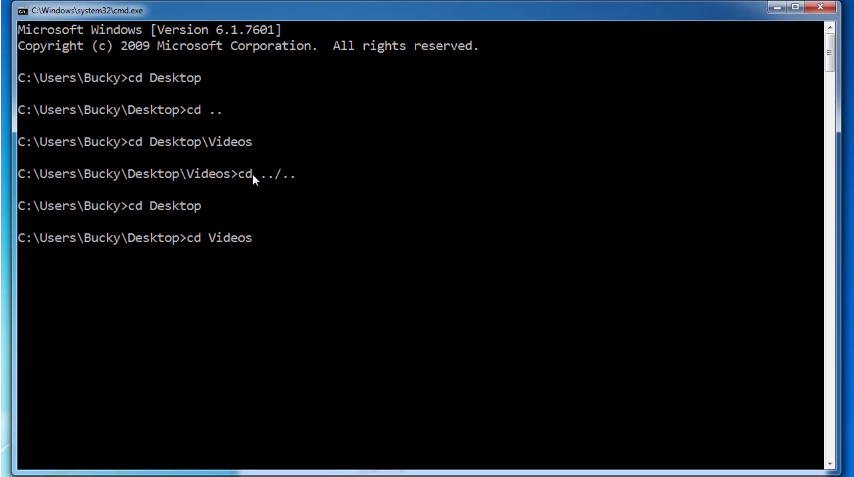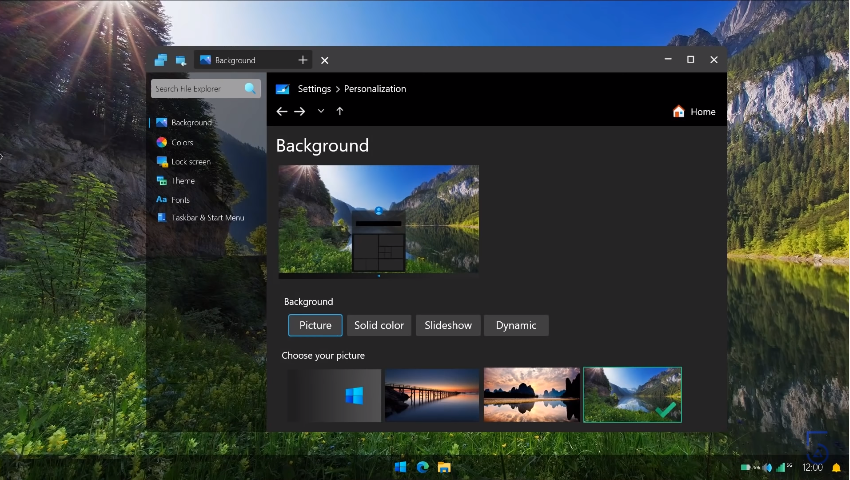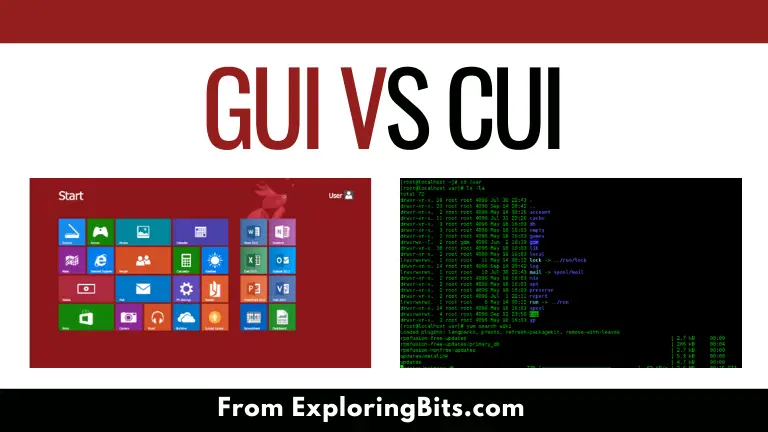The interface can be understood as the medium we communicate with each other. In the same way, to communicate with the computer we have interfaces. There are two types of interface one is the graphical user interface and the other one is the command-line interface.
According to Wikipedia –
Command User Interface – A command user interface (CUI) processes commands to a computer program in the form of lines of text. The program which handles the interface is called a command-line interpreter or command-line processor. Operating systems implement a command-line interface in a shell for interactive access to operating system functions or services.

Graphical User Interface – The graphical user interface (GUI) is a form of user interface that allows users to interact with electronic devices through graphical icons and audio indicators such as primary notation, instead of text-based user interfaces, typed command labels or text navigation.

Difference between GUI and CUI
![Difference between GUI and CUI [ CUI Vs GUI ]](https://exploringbits.com/wp-content/uploads/2020/11/Difference-between-GUI-and-CUI-CUI-Vs-GUI-.png)
Command User Interface
The command user interface is also known as the character user interface, this is because the character denotes what we are trying to communicate to the computer. These sets of characters are called text, and the user issues command as one or more lines of text to the operating system. The examples of command-line user interface Linux Kernel, Windows Command Prompt, and MS-DOS, electromechanical teletype machines.
The earliest example of the command user interface is the electro-mechanical teletype machines. When people started achieving 100 words per minute on the normal typewriter machine, these typewriters were found to be the best fit for human-computer interaction.
The teletype machines used telegraph wire to send and receive the message. So, if a person types some words on Teletype machine A, the same words will be typed automatically to the telegraph wired connected teletype machine B on the piece of paper. This allowed people to interact with each other over long distances.
The teletype machines seemed the best fit for human-computer interaction. The teletype machines were popular in the 1960s and 1970s, and these teletype machines became one of the first examples of a command user interface. The person will interact with the teletype machines by writing some predefined commands to the computer and in response to those commands, the computer will type the outputs back on the paper. The command user interface remained popular till the early 1980s.
The electromechanical teletype machines were the primary computer interface for the users till the 1970s, although the monitor screen first emerged during the 1950s but due to their low resolution and expensive to be integrated into the computer systems.
But the mass production of the television for the consumer market in the 1970s along with the improvement of computer processors made computer screens viable and it replaced the early electromechanical teletype machines.
The engineers simply replaced the teletype machine papers with television screens, keeping all the commands the same. For computer systems, the computer screen was an endless loop of papers on which it could reply back. These computer screens also became known as terminals. During 1971, it was found that seventy thousand computers were teletype machines and seventy thousand computers were screen based. But due to computer screen flexibility of use, for example, deleting a mistake on a computer screen was a simple task of pressing a button on a keyboard whereas the same mistake on a paper would require a whitener to cover them. Due to these reasons at the end of the 1970s, the computer screen became the standard for computer systems.
In the command user interface early period, the programmer created fiction based computer games. These games would take input such as Yes/No or Left/Right from the user and as the result, they will output the fiction-based text scenario on the computer screen based upon the choice of the user.
Also today, computer programs are very much text-based writing tasks. The command user interface is the natural interface for programmers. Also, command user interfaces are highly used in interacting with computer networks such as servers that are far away. The command user interface is very much available to every windows and mac user. For accessing the command user interface simply type cmd on the search bar in windows and experience the command user interface. The command user interface is therefore the first choice for many technical users and programmers.
To work on CUI the programmer needs to remember the syntax of the command. Today, the development in CUI has provided a great facility to handle the errors in the command lines but earlier it was very difficult to find the exact place or reason for the error.
Command user interface features
- In a command-line interface, you can run only one command line at a time therefore it does not support the same multitasking functionalities that the graphical user interface has.
- The navigation of the command-line interface is a hectic task, if you want to navigate which lines of code are running and which have been already done then you will have to scroll all the lines of code that are present onto the screen till then.
- For the command user interface, all the lines of commands have to be written on the screen with the help of the keyboards.
- The command user interface has a higher speed as compared to the graphical user interface because the command user interface only requires a black screen and a keyboard to operate whereas a graphical user interface requires a lot of user devices and screen processing to be done which makes it slower than a command-line interface.
- The command-line interface requires a lot less memory than the graphical user interface because it does not require any images for process operation.
- The command-line interface does not have enough customizable options and does not offer user-friendliness.
- The command user interface is less expensive than the graphic interface as it requires less memory and processing to display the text on the monitor rather than the graphical interface.
Graphical User Interface
The graphical user interface completely changed the way we interacted with the computer. The Graphical user interface was more intuitive to use, now anybody, not just a computer hobbyist or computer scientist can figure things out on the computer.
The advent of graphical user interfaces started when applications such as sketchpad were developed by Ivan Sutherland. But these applications were not integrated with the computer system. The real father of Graphical user interface was Douglas Engelbart. Douglas Engelbart saw computers can be used for far more interactive problem-solving tasks rather than automated machines.
Later on, Engelbart faced with the problem of lack of device that he required to augment the problem to be solved with the help of a graphical interface. This device was later developed by Bill English and the device was ‘mouse’ which helped to move the cursor on the interface with sliding of the device on the desk. With the help of a mouse and his idea to implement GUI with computer systems, Engelbart demonstrated the first GUIs which have all the features of modern-day computers.
Though Engelbart’s research and efforts were successful and he was also awarded the Turing award for his work but the product failed in the commercial market. It was at the Xerox PARC the real advancement in the GUIs were carried on. For the GUIs to be really intuitive it has to be constructed around fairly common objects and this object was the ‘Desktop’. The Xerox PARC treated the 2D screen of the computer as the top of the Desk and that became the ‘Desktop Metaphor’.
The application and folders were able to slide on each other as the papers can on the desk. The Xerox PARC kept refining the hardware and the software technology of its GUIs and packed all these technologies on the product called Xerox Star. The Xerox star was really ahead of its time and it also incorporated the WYSIWYG ‘What-You-See-Is-What-You-Get’ this way people can actually see what is printed by the printers on their desktop. Because of its functionalities, the Xerox Star came with a price tag of $200,000 today. The product was not a commercial hit due to its price tag.
The effort of the decade long did not go to waste, Steve Jobs at Apple saw the GUI implementation at Xerox PARC which led to the deal between Xerox and Apple. Later at Apple, Steve Jobs with his team developed the Graphical User Interface for the commercial market and prepared its project named Macintosh. The Macintosh was an instant hit and that brought the era of GUIs into the computer world leading companies such as Windows and IBM to bring their GUIs into the market.
Graphical user interface features
- The same operation that is performed with the command user interface can be performed with the help of graphical images such as icons and screens then this interface is called the graphical user interface.
- The graphical user interface has a multitasking facility which means that it can support many operations at the same time with the help of graphical and visual cues.
- The graphical user interface creates a great way to navigate the operations that the computer is performing and this, therefore, shows that the graphical user interface is much easier in Operation than the command user interface.
- In the graphical user interface, all the commands are performed with a combination of both the mouse as well as the keyboard, and also the graphical user interfaces only introduced us to the concept of using the mouse on the screen which was never thought of while in the command user interface.
- The graphical user interface is slower than the command line interface as it requires more processors for the screen than it would have normally required only using a screen and keyboard.
- To make a graphical user interface more user-friendly the requirement for storing images in memory becomes essential and therefore it requires more memory storage than it would ever in using the command-line interface.
- The graphical user interface has a lot more customizing options than any command-line interface operating system can support.
- The graphical interfaces are much more expensive than the command user interface because of their more requirement of processing speed and memory.
Aayush Kumar Gupta is the founder and creator of ExploringBits, a website dedicated to providing useful content for people passionate about Engineering and Technology. Aayush has completed his Bachelor of Technology (Computer Science & Engineering) from 2018-2022. From July 2022, Aayush has been working as a full-time Devops Engineer.
